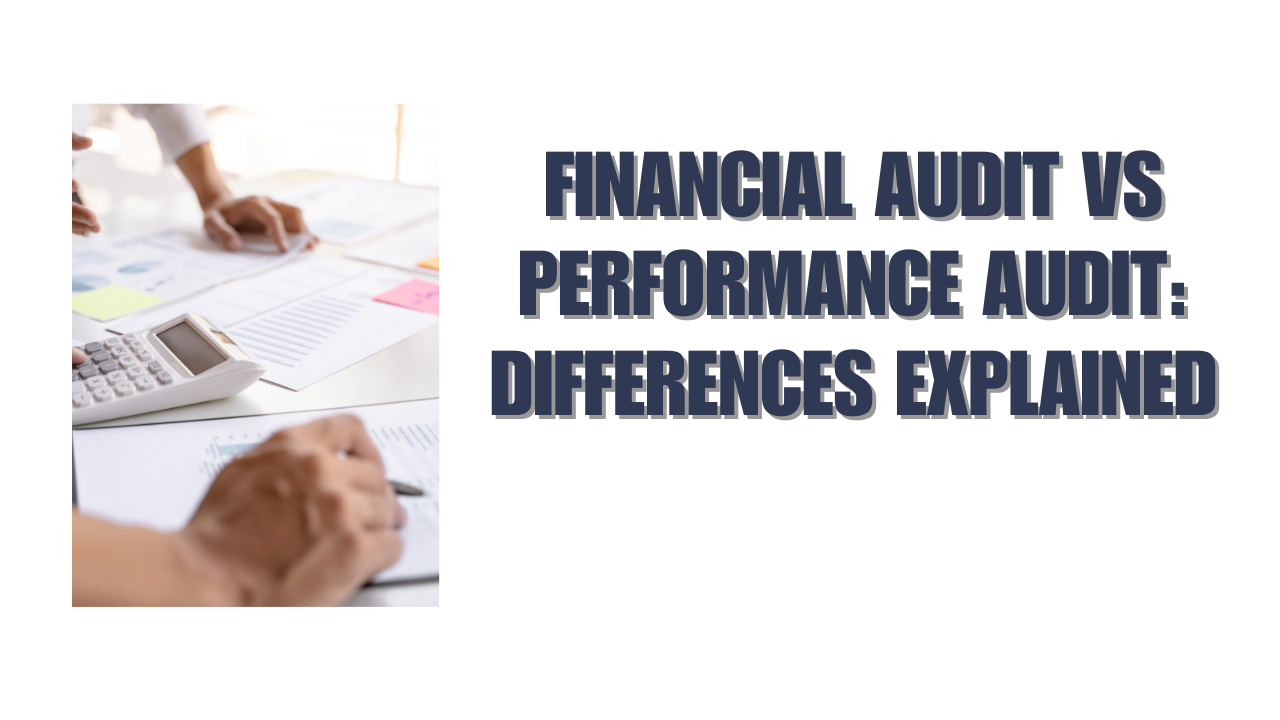Financial audit vs performance audit creates confusion among many business professionals. These two types are classified as “assurance engagements” under the detailed Yellow Book standards, but they serve different purposes. They stand as the only engagements officially called “audits” among the four recognized assurance categories.
Organizations need to know the significant differences between financial and performance audits to choose the right evaluation. Financial audits verify accounts and financial statements’ accuracy on a yearly basis. Performance audits optimize operations and address specific issues without following a set timeline. New Zealand’s audit practices demonstrate this difference clearly. The Auditor-General’s office handles about 50% of financial audits and earned a remarkable 97% “satisfactory” rating for appointed auditors in 2015/16. This piece offers a CPA’s viewpoint to help you learn about financial audits and understand how performance audit methods differ from financial ones.
Defining the Two Audit Types
The difference between audit types plays a key role for organizations that need proper financial oversight. Let’s look at what makes each type of assessment unique.
What are Financial Audits?
Financial audits are objective reviews of an organization’s financial statements and records. These audits check if financial statements are fair and accurate according to accounting standards, usually GAAP. Auditors look at business transactions, procedures, and balances to ensure everything adds up. While they can’t guarantee perfection, financial audits give us a high level of confidence that the financial information is correct.
Most companies need financial audits regularly. The focus stays on numbers and account accuracy rather than how things run. Auditors must stick to AICPA standards when they do their work. They give their opinion about the business to lenders, creditors, and investors once they’re done.
What are Performance Audits?
Performance audits show how well an organization runs. These audits look at programs, functions, and operations to see if they meet their goals. Performance auditors can review almost anything against laws, regulations, standards, or measurements.
Performance audits target specific issues and find out what causes them instead of following a set schedule. They focus more on people and resources than numbers. The U.S. Government Accountability Office (GAO) sets relaxed standards for these audits in the Yellow Book.
Audit vs Review NZ: Where Do They Fit?
New Zealand organizations need to know the difference between audits and reviews. Both give independent opinions on financial statements but with different levels of certainty. Audits provide more confidence through complete checking, while reviews offer basic assurance through analysis and questions.
New Zealand’s registered charities face specific rules. Organizations spending over NZD 938,085.65 need their financial statements either audited or reviewed. Those spending more than NZD 1.88 million must get a full audit. Reviews are more affordable – they cost 10-15% less than audits.
Core Differences in Scope and Objectives
The main difference between financial audit and performance audit shows up in what they aim to do and how they do it. Organizations need to know these key differences to pick the right type of audit they need.
Focus Area: Accuracy of Accounts vs Operational Efficiency
Financial audits check if financial statements match recognized accounting frameworks like GAAP. These audits make sure that all financial information presents a fair picture of the company’s status. Auditors look at financial transactions, procedures, and balances to confirm the organization’s true financial position.
Performance audits look at the “three E’s” – economy, efficiency, and effectiveness of operations. They check if organizations get their resources at good prices and use them well to meet their goals. These auditors go beyond just checking numbers. They assess how well management handles things like leadership, employee development, and productivity.
Audit Frequency: Annual Cycles vs As-Needed Reviews
Financial audits happen yearly to meet legal reporting requirements. Public companies must have these audits by law under rules like the Sarbanes-Oxley Act. Regular cycles help verify financial reports consistently.
Performance audits work differently. Companies run them when needed. They target specific issues rather than following fixed schedules. The Auditor-General can start performance audits any time to check activities, compliance, or possible waste. This flexibility lets companies tackle efficiency problems quickly.
Subject Matter: Financial Statements vs Programs and Policies
Financial audits stick to financial statements and related papers. They check if financial information follows the right reporting rules and doesn’t have major errors.
Performance audits cover more ground. They look at organizational, financial, service delivery, and administrative functions. These audits can measure almost anything against laws, regulations, standards, or benchmarks. They often dig into specific programs, operations, or policies to see if they’re doing what they should.
Standards and Methodologies Used
Regulatory frameworks shape how financial and performance audits work, creating clear paths for practitioners. These different standards shape how teams conduct and report each type of audit.
Governing Bodies: AICPA vs GAO Yellow Book
The American Institute of Certified Public Accountants (AICPA) sets the standards for financial audits. The Government Accountability Office’s (GAO) Yellow Book, also known as Generally Accepted Government Auditing Standards (GAGAS), guides performance audits. The Yellow Book covers both types of audits in different chapters. The 2024 Yellow Book revision brings significant changes that focus on quality management systems and risk-based approaches to audit quality. This new framework puts more emphasis on active monitoring and makes leadership responsible for engagement quality.
Audit Criteria: GAAP vs Performance Benchmarks
Financial audits check if organizations follow Generally Accepted Accounting Practice (GAAP) and if their financial statements show their true financial position. Auditors match financial statements with proper documentation to check accuracy. Performance audits use a wider range of criteria, including laws, regulations, standards, and specific benchmarks that match the audit’s goals. The audit team creates criteria to assess how well and efficiently an organization works. This flexibility lets performance auditors look at almost any subject matter against relevant standards.
Documentation and Reporting Requirements
Each audit type needs different documentation. Financial audits need complete records of financial performance, position, equity movements, cash flow, accounting policies, and notes. Company directors must sign these statements before or on the audit report’s date. Performance audit documentation follows a clear process with scoping, planning, fieldwork, and reporting stages. The final performance audit reports go to Parliament and become public, with the team briefing key stakeholders. Both types of audits need solid evidence to back up their findings and conclusions.
Real-World Applications and Use Cases
Real-life examples show how financial and performance audit methods work in various organizations. These case studies show their unique purposes and how organizations implement them.
Examples of Financial Audit Scenarios
Publicly traded companies commonly use financial audits to comply with financial reporting requirements. External financial audits look at financial statements, accounting policies, and internal controls over financial reporting. To name just one example, Apple and Microsoft’s detailed financial statements show transparency that builds investor trust. The Enron scandal serves as a warning about audit failure, where Arthur Andersen missed fraudulent financial reporting. This ended up leading to regulatory reforms like the Sarbanes-Oxley Act.
Examples of Performance Audit Scenarios
Performance audits tackle specific operational challenges. A large nonprofit’s audit had a broad scope at first but moved its focus to fundraising operations. This led to recommendations that increased donor engagement by 40%. Another performance audit found inefficiencies in supplier contracts that cost a company 5% extra in procurement expenses. The company saved money through contract renegotiations. The Auditor-General completes about 15 performance audits yearly.
Who Conducts Each Type of Audit?
Independent certified public accountants (CPAs) from external firms typically handle financial audits. Government audit bodies at federal or state levels often carry out performance audits. New Zealand’s Auditor-General has the power to conduct performance audits of Commonwealth entities, companies, and their subsidiaries. Organizations’ internal audit teams can conduct either type, though external audits provide better independence and objectivity.
How Agencies Prepare for Each Audit Type
The preparation process is quite different between audit types. Organizations should gather and organize their documentation for financial audits. They need to spot potential issues early and answer questions honestly. Sound systems and processes make performance audit preparation easier. Organizations should ensure their student experience meets requirements. Regular self-assessment helps fulfill legal and management responsibilities.
Comparison Table
| Aspect | Financial Audit | Performance Audit |
|---|---|---|
| Main Focus | Accuracy of financial statements and records | Operational efficiency and effectiveness (the “three E’s” – economy, efficiency, effectiveness) |
| Purpose | Check if financial statements are fair and accurate | Look at how well an organization runs its operations |
| Frequency | Yearly cycles based on legal requirements | Happens when needed, with no set schedule |
| Standards/Guidelines | AICPA standards | GAO Yellow Book (GAGAS) |
| Subject Matter | Financial statements, transactions, procedures, and balances | Programs, functions, operations, policies, and administrative tasks |
| Who Conducts It | External CPAs from independent firms | Government audit teams, internal auditors |
| Documentation Needs | Complete financial records, statements of financial performance, position, equity, cash flow | Well-laid-out process with scoping, planning, fieldwork, and reporting stages |
| Criteria Used | Generally Accepted Accounting Practice (GAAP) | Laws, regulations, standards, and specific performance standards |
| Level of Assurance | High but not absolute assurance | Not specified |
| Reporting Outcome | Audit opinion for lenders, creditors, and investors | Reports go to Parliament and become public |
Conclusion
The difference between financial audit vs performance audit helps organizations make better decisions about their assurance needs. Our detailed comparison shows how these two audit types serve completely different purposes, even though both are called “audits.”
Financial audits focus on the accuracy and fairness of financial statements. They follow GAAP standards and run on yearly cycles. Performance audits get into operational efficiency and effectiveness. They target specific problems instead of following fixed schedules. This shift in focus shows their different goals – one checks financial accuracy while the other improves how organizations work.
The standards that govern these audits are substantially different. Financial audits use AICPA guidelines, and performance audits follow the GAO Yellow Book standards. Independent CPAs usually handle financial audits, while government bodies take care of performance audits.
Both types need proper documentation, but their reporting requirements and outcomes are quite different. Financial audits create opinions for stakeholders like lenders and investors. Performance audit reports become public documents that go to Parliament.
Organizations should pick the audit type based on their specific needs. Financial audits give essential proof about financial reporting accuracy. Performance audits are a great way to get insights into operational efficiency. Many organizations use both types effectively – financial audits on regular cycles and performance audits when operational concerns come up.
FAQs
Q1. What are the main differences between financial audits and performance audits?
Financial audits focus on the accuracy of financial statements and follow annual cycles, while performance audits examine operational efficiency and are conducted as needed. Financial audits primarily look at figures, whereas performance audits pay more attention to people and resources.
Q2. Who typically conducts financial audits and performance audits?
Financial audits are usually performed by independent Certified Public Accountants (CPAs) from external firms. Performance audits, on the other hand, are often carried out by government audit bodies at federal or state levels, or by internal audit teams within organizations.
Q3. What standards govern financial audits and performance audits?
Financial audits follow standards established by the American Institute of Certified Public Accountants (AICPA), while performance audits adhere to the Government Accountability Office’s (GAO) Yellow Book, also known as Generally Accepted Government Auditing Standards (GAGAS).
Q4. How do the reporting outcomes differ between financial and performance audits?
Financial audits produce audit opinions for lenders, creditors, and investors about the accuracy of financial statements. Performance audit reports are typically presented to Parliament and become public documents, offering insights into operational efficiency and effectiveness.






